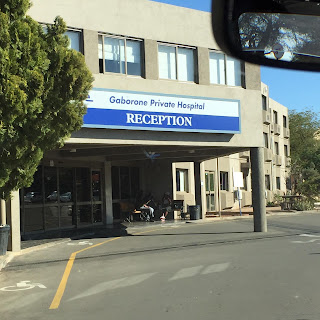Hello from Gabarone,
I am now half way into my trip and I thought this might be a
good time to sit and reflect on the things I have learned/experienced so far. The major lesson I learned is that more
questions arise than there were answers. The choice to come Botswana stemmed from an
already established collaboration between the Oncology department at MGH and two
hospitals in the city of Gaborone (one public/government run) and one private
which services government insured patients for certain aspects of care mainly
with regards to oncology. The objectives were a few fold help
establish breast cancer guidelines in hopes of standardizing treatment of
breast cancer patients. Additionally, I hoped to assist with setting up a multi
disciplinary breast clinic to make the transition for patient much easier.
Both have come with challenges as well as some progress. In
trying to adapt the breast cancer guidelines used in the US, I had to get input
from physicians who practice here in Botswana. Immediately you realize that
cancer in the US is very different from Cancer in Botswana. For example where
as we have screening guidelines and yearly mammography to detect early and
occult malignancies, one of the physician’s quotes that 99% of breast cancer
patients that they encounter self palpated a mass. This essentially means that the breast cancer
is locally advanced and diagnosed at a much later stage. This also means that
things like breast conserving surgeries which is a viable option in the US is
not an option in Botswana i.e women who come to attention for management of
breast cancer, get mastectomies. So the questions: why are women diagnosed so
late? Why is there no capacity for
screening, is it an acceptable fact young women are dying of potentially
curable malignancies? In a country where breast are associated with femininity,
is late stage disease resulting in mastectomies the best that can be done? There
are so many questions…
Back to the guidelines, even though currently the guidelines
are a skeleton compared to the one used in the US, it leaves a lot of room for
improvement, which is a major positive. Also all the physicians were on board
that these guidelines were in deed important and were mostly willing to
contribute from their perspectives so that care can be standardized.
With regard to the multi disciplinary clinic, the major limitation
currently is finding an adequate space that would allow all the participating physicians
to evaluate the patients’ together.
Also hiring a nurse that could staff that clinic full time has been a
challenge. Even though the government has the capacity, I have learned is that
cancer is not quite as high a priority as infectious disease for example. The
nation wide campaign against HIV and TB has been remarkable partly because the
percentages of both are so high and there were enough interested parties to
highlight the toll these diseases were taking on the population. Being an
optimist though, I think there are enough interested parties that want to
change the thinking about cancer; I believe the break through is just around
the corner, at least I hope.
In terms of helping the to stream line the process for
patients, I am setting up a meeting with a physician who works with the ministry
of health to discuss efforts to educate local providers and health care workers
to recognize warning signs and symptoms and also to focus on age appropriate screening
as part of their general check up, stayed tuned for the results of that meeting
on the next post.



No comments:
Post a Comment